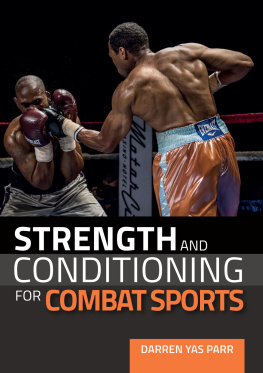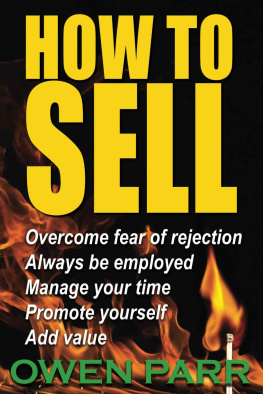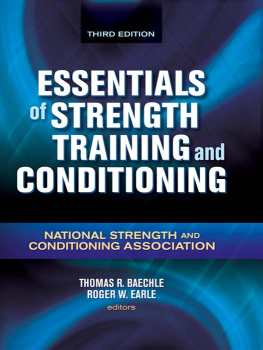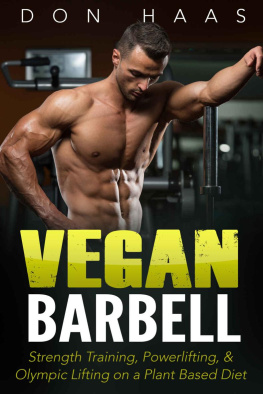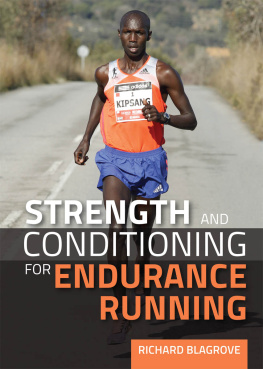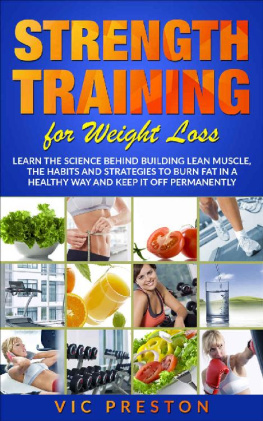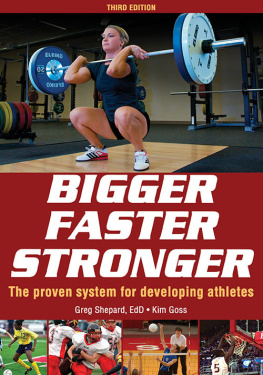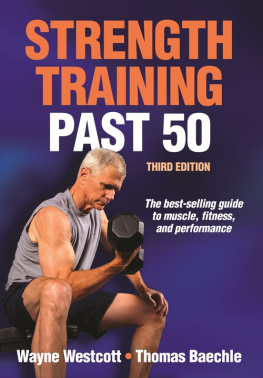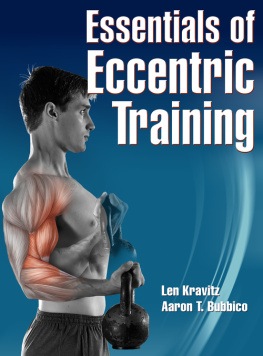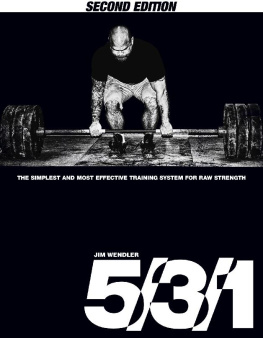STRENGTH
AND
CONDITIONING
FOR
COMBAT SPORTS
DARREN YAS PARR

STRENGTH
AND
CONDITIONING
FOR
COMBAT SPORTS
DARREN YAS PARR

THE CROWOOD PRESS
First published in 2018 by
The Crowood Press Ltd
Ramsbury, Marlborough
Wiltshire SN8 2HR
www.crowood.com
This e-book first published in 2018
Yas Parr 2018
All rights reserved. This e-book is copyright material and must not be copied, reproduced, transferred, distributed, leased, licensed or publicly performed or used in any way except as specifically permitted in writing by the publishers, as allowed under the terms and conditions under which it was purchased or as strictly permitted by applicable copyright law. Any unauthorised distribution or use of thistext may be a direct infringement of the authors and publishers rights, and those responsible may be liable in law accordingly.
British Library Cataloguing-in-Publication Data
A catalogue record for this book is available from the British Library.
ISBN 978 1 78500 406 3
Frontispiece: Mark Ruddick
Acknowledgements
Id like to say a big thank-you to my friends and family for their support, especially my wife Liz Q.
C ONTENTS
F OREWORD
Over many years Yas Parr has dedicated himself to developing the most efficacious methods of strength and conditioning for combat athletes. This book details all this knowledge into a well-constructed compendium that will be invaluable to any coach or athlete involved in combat sports.
Professor Ian Jeffreys, PhD, RSCC*E, CSCS*D, ASCC, FUKSCA, FNSCA
Director of Strength and Conditioning University of South Wales
I NTRODUCTION
What is Strength and Conditioning?
Strength and conditioning is the physical development of athletes for elite sport performance. The role of the S&C coach is to bridge the gap between the theory of training and applied training, helping athletes to become faster, stronger and more flexible and to build their muscular endurance so they perform better and remain injury free.
Strength and conditioning is about more than lifting weights it encompasses the entire development of the athlete and what is needed to improve physical performance. This includes plyometrics, speed and agility, endurance and core stability, with strength training being just one piece of the jigsaw.
A Strength and conditioning coach works alongside a sports coach to assist him or her in designing specific programmes that will address the particular needs of the athlete, team and sport. There are many ways a well-constructed programme can add to the rehabilitation, speed, agility, endurance and strength of the athletes, although a periodized one that targets both strengths and weaknesses will produce the best possible performance. (English Institute of Sport)
What is a Strength and Conditioning Coach/Specialist?
An S&C coach is a practitioner with the specialist skills and competencies for the planning and implementation of physical preparation programmes for performance. It includes processes that result in physical adaptation through integrating fitness components into a programme, which complements other aspects of the performers development. This includes, though not exclusively, strength, speed, power, endurance, agility and flexibility (Jeffreys, I., 2011).
A strength and conditioning specialist is not a:
Fitness instructor
Personal trainer
Physiotherapist/physical therapist
Exercise physiologist
Bodybuilder
Sports coach
(Jeffreys, I., 2011)
S&C is the fastest growing sector for elite sport. When deciding on a coach or specialist, you should look for:
A degree
Accreditation
Experience
Competency
The strength and conditioning coach for a combat athlete will be able to perform a needs analysis in which both the fighter as an individual and the sport performed will be assessed and from the evaluation a high performance programme can then be written. This programme will be designed to increase strength, speed, power, endurance, agility and flexibility.
As previously stated, a strength and conditioning coach is a specialist in his own right and is not to be confused with the occupations from the above list, which often assume to take on the role for the fighter looking for a performance enhancement programme.
Accreditation
ASCA Levels 0-3: Intern, Professional, Elite and Master S&C Coach
NSCA Certified Strength and Conditioning Specialist (CSCS)
UKSCA Accredited Strength and Conditioning Coach (ASCC)
OLD SCHOOL
VS NEW SCHOOL
OLD SCHOOL
As fighter training is so traditionally old school the standard of strength and conditioning in the majority of combat sports is at best many, many years behind other sports.
MMA, more than likely because it is a new sport, tends to be a long way in front of the others when it comes to how the fighters are trained, and even then it is only certain individuals who receive the level of training that could be expected by elite athletes in other sports. At the total opposite end of the scale are Western-style boxers, with most of their fitness training at best decades behind other top-level athletes.
However, it does seem that times are changing, although this is dependent on geography. British and Eastern European boxers are stepping up their game and are training to become much more powerful. They now seem to have got the message that training to improve power takes them to another level, while their American counterparts are still swimming and doing 10-mile runs to prepare for competition.
Australian boxers are rising fast and those that are achieving success also seem to be employing high-quality strength and conditioning coaches that know better than to have their fighters doing the old school training.
Thai boxers, kick boxers and every other type of combat athletes/martial artists tend to fall somewhere in the middle. These combat sports tend to be so set in their ways that its difficult for a fighter to get elite level training for performance enhancement.
Boxing and Thai boxing trainers and the fitness experts that are often employed at traditional fighting gyms tend to have the fighters do what they did when they trained to fight and this philosophy was passed down from their trainers. Most trainers involved tend to have this attitude and those who are a little more open to up to date strength and conditioning very often employ a person with an interest in fitness or fighting or just a run of the mill personal trainer.
The general idea with a fighters conditioning is that if something is difficult or tiring, then it must be beneficial. After a general preparation phase there has to be a specific preparation phase, meaning the training done by the fighter has to have transference to the sport/art.
This book is written with the goal of training the combat athlete to be stronger, faster and have the ability to display these values for longer. It is a book that provides valuable information on not just how to become strong but how to produce this strength fast. It also advises on conditioning and, while most coaches that train fighters are either overly obsessed with aerobic conditioning or are aerobicphobic, this book takes a logical stance on the subject as extreme views are very rarely optimal.
The majority of a typical fighters strength and conditioning training has absolutely no transference to what they do and actually makes them slower and weaker. Whilst using a sauna suit may be justifiable when a fighter is attempting to make weight, the use of one in everyday training under the illusion that it will cause fat loss is very nave. Body temperature is raised while training, leading to increased perspiration. However, that is all it is: a reduction in weight due to the dehydration effect; the weight is just as quickly put back on when the athlete rehydrates. As already mentioned, the sauna suit can be a very useful tool for an athlete when cutting weight but, as with any other tool used for this purpose, it carries potential dangers that the experienced fighter and coach will be well aware of such as: dehydration, hyperthermia, and excessive mineral and electrolyte loss. The same can also be said for products such as Sweet Sweat and the make-up remover Abolene, which are very useful tools for cutting weight but are quite useless when it comes to acting as an agent for fat loss.
Next page
